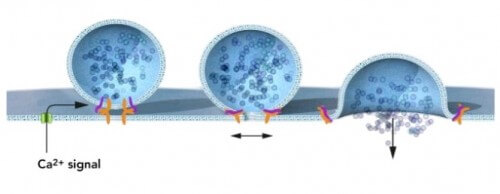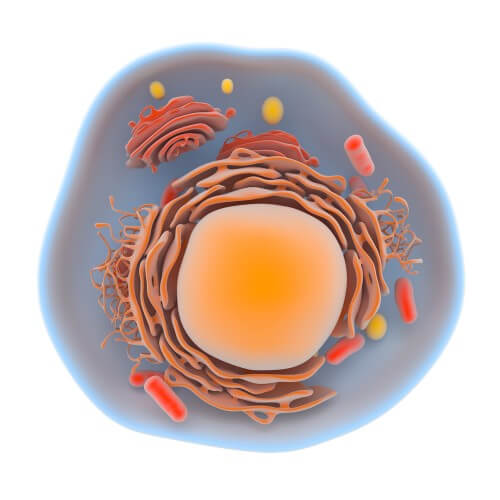Three American researchers: James Rothman, Randy Schackman and Thomas Sudhoff revealed in yeast, mammalian cells and human neurons that there is a lot in common in the transmission of messages through neurotransmitters in the brain, the transmission of insulin and more

Updates on the Nobel week: Tuesday - announcement of the winners of the Nobel Prize in Physics. Wednesday - the announcement of the chemistry winners, Thursday (probably) literature, Friday - the announcement of the Nobel Peace Prize winners, and the following Monday - economics. We will also bring the announcements in physics and chemistry live on the science website.
The Nobel Prize Committee for Medicine and Physiology, operating from the Karolinska Institute, decided to award the 2013 Nobel Prize in Medicine jointly to three American researchers: James Rothman (Rothman) from Yale University, Randy Schekman (Schekman) from Berkeley University and Thomas Südhof (Südhof) from Stanford for their discovery of the regulating mechanism the movement of the vesicle - the main transport system of our cells.
The 2013 Nobel Prize honors three scientists who solved the mystery of how the cell organizes its transport system. Each cell is a factory that extracts and imports molecules. For example insulin is produced and released into the bloodstream and chemical signals called neurotransmitters are sent from one nerve cell to another. These molecules are transported inside the cell in small packages called vesicles. The three Nobel laureates discovered the molecular principles that control the way in which this charge is transported to the right place at the right time inside the cell.
Randy Schackman discovered a series of genes that were required to transfer the vesicles. James Rothman uncovered the protein mechanism that allowed these vesicles to fuse with their targets to allow cargo to be transferred. Thomas Sudholf revealed how the signals tell the vesicles to release their cargo with great precision.
Thanks to their discoveries, Rothman, Shakman and Sudhoff revealed the fine control system of the transport and delivery of the cellular cargo. Disorders in this system cause conditions such as neurological diseases, diabetes and disorders of the immune system.

How charge is transported within the cell
In a large and busy port, systems are needed to ensure that the right cargo is delivered to the right destination at the right time. The cell, with all its various components called organelles, faces a similar problem: the cells produce molecules such as hormones, neurotransmitters, cytokines and enzymes that need to move to other places inside the cell or go out to other systems in the body at exactly the right moment.
Timing and placement are of the essence. Miniature bubble-like vesicles surrounded by membranes transfer the cargoes between the organelles or fuse with the cell membrane and release their cargo to the outside. This is a highly important process, because it drives the nerve activity in the case of the transmitter components or controls the metabolism in the case of hormones. How do these vesicles know when and where to transfer their refreshment?
Traffic jams reveal the genetic control mechanism
Randy Schackman was fascinated by the way in which the cells organize the transport system and in the seventies he decided to investigate the genetic basis by using yeast as a model system. In a genetic scan, he identified yeast cells with defects in the transport system. The vesicles piled up in certain areas of the cell. He found that the cause of the traffic jam was genetic and proceeded to identify the mutated genes. Shakman identified three types of genes that control different aspects of the cellular transport system and thus he provided new insight into the tight regulatory mechanism that mediates the transfer of vesicles into the cell.
Accurate docking
James Rothman was also intrigued by the nature of the cellular transport system. When he studied the transfer of vesicles in mammalian cells in the XNUMXs and XNUMXs, Rothman discovered that a combination of proteins allows the vesicles to anchor and integrate into their target membrane. In the fusion process, the proteins in the appendages and those of the target membrane bind together like two sides of a zipper. The fact that there are many proteins of this type and they bind only in specific combinations ensures the transfer of the charge to the exact location. The same principle works inside the cell and also when the vesicles bind into the cell membrane to release the cargo outside.
It turned out that some of the genes Schakman discovered in yeast encode the proteins Rothman had identified in mammals, which indicated the evolutionary origin of the transport system. Collectively they mapped the critical components of the intracellular transport mechanism.
Timing is everything
Thomas Sudhoff was interested in the question of how nerve cells communicate with each other within the brain. The signaling molecules, the neurotransmitters, are released from the vesicles that fuse with the outer membrane of the nerve cell using a mechanism discovered by Rothman and Shekman. However, these vesicles only allow their contents to be released when the nerve cell sends signals to its neighbors.
How is the release so precisely controlled? Calcium ions were known to be involved in the process and in the nineties Sudhoff looked for calcium-sensitive proteins in nerve cells. He identified a molecular mechanism that responds to the influx of calcium ions and instructs the neighboring proteins to bind the vesicles to the outer membrane of the nerve cell. The zipper opens and the signaling materials are released. Sudhoff's discovery explains how precise timing is achieved and how the contents of the vesicles can be released on demand.
Vesicle traffic gives us insight into disease processes
The three Nobel laureates discovered basic processes in cell physiology. These discoveries have important implications for our understanding of how cargo is transported with timing and precision in and out of the cell. The mechanism of vesicles and their fusion works according to the same general principle in different organisms as yeast and humans. The system is critical for a variety of physiological processes in which the melting of the vesicles must be controlled, from signaling the brain to release hormones to the cytokines of the immune system. Defects in the vesicular transport system occur in a variety of diseases, including neurological and immunological disorders, as well as diabetes. Without this incredibly precise organization, the cell would collapse into chaos.
James Rottman was born in 1950 in Hillhill, Massachusetts in the USA. He received his doctorate from Harvard Medical School in 1976, served as a postdoctoral fellow at MIT and moved in 1978 to Stanford University in California, where he began his research on vesicles inside cells. Rothman also worked at Princeton University, Memorial Sloan-Kettering Cancer Center and Columbia University. In 2008 he joined the faculty of Yale University in Connecticut where he serves as Professor and Chair of the Department of Cell Biology.
Randy Schackman was born in 1948 in St. Paul, Minnesota, studied at the University of California in Los Angeles and Stanford where he received his doctorate in 1974 under the guidance of Arthur Kornberg (1959 Nobel laureate) and in the same department that Rothman joined a few years later. In 1976 Shakman joined the faculty of the University of California at Berkeley where he is currently a professor in the Department of Molecular Biology and Cell Biology. Shakman is also a researcher at the Harvard Hughes Medical Center.
Thomas Sudhoff was born in 1955 in Göttingen, Germany. He studied at the Georg August University in Göttingen where he graduated with an MD degree in 1982 and a PhD in neurochemistry the same year. In 1983 he moved to the Texas Southwest Medical Center in Dallas in the USA as a postdoctoral fellow together with Michael Brown and Joseph Goldstein (who shared the Nobel Prize for Medicine in 1985). Sudhoff became a researcher at the Howard Hughes Institute in 1991 and was appointed professor of molecular and cellular biology at Stanford in 2008.
It should be noted that the three researchers who won were not targeted by Thomson Reuters, the body that tries to estimate every year who will be Nobel winners, and which Among the three possibilities he also included the discovery of Prof. Haim Sider and Aharon Razin from the Hebrew University about DNA methylation.
An explanation for the advanced

6 תגובות
Water blowing
This is a scientific site. To put it mildly, the rabbi did not exactly contribute to the issue...
Father, with all due respect, I don't think it is possible for "such things as the conversion" to pass through the ranks of writing books, which will receive the mitzvot as they say
Point, I have hundreds of books at home (including one that I wrote, not 50 like him, although only from the technical point of view of the word count I probably exceeded it by orders of magnitude by writing on the website) but I also have access to the Internet which is equivalent to billions of books.... And he didn't have that.
Will the science website do an article on Maran?
Nevertheless, in terms of knowledge he had enormous knowledge, in his house there were more than 10 thousand books so I heard now.
: )
Not anti-Semitic, I mean anti-Israeli, after all the winners are Jewish.
antisemitic They stole our prize